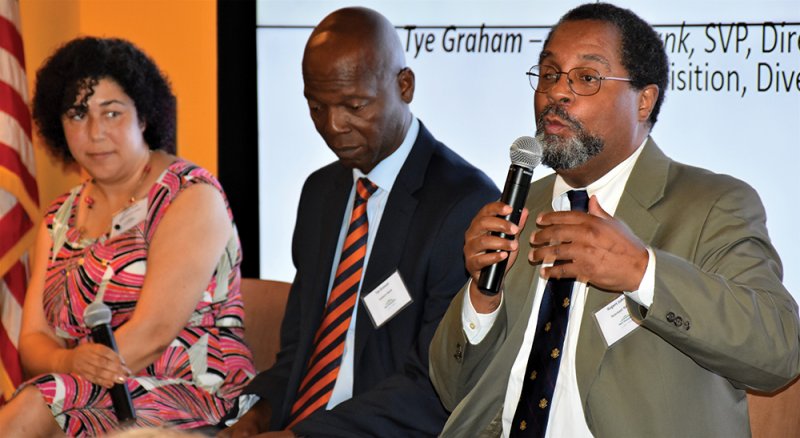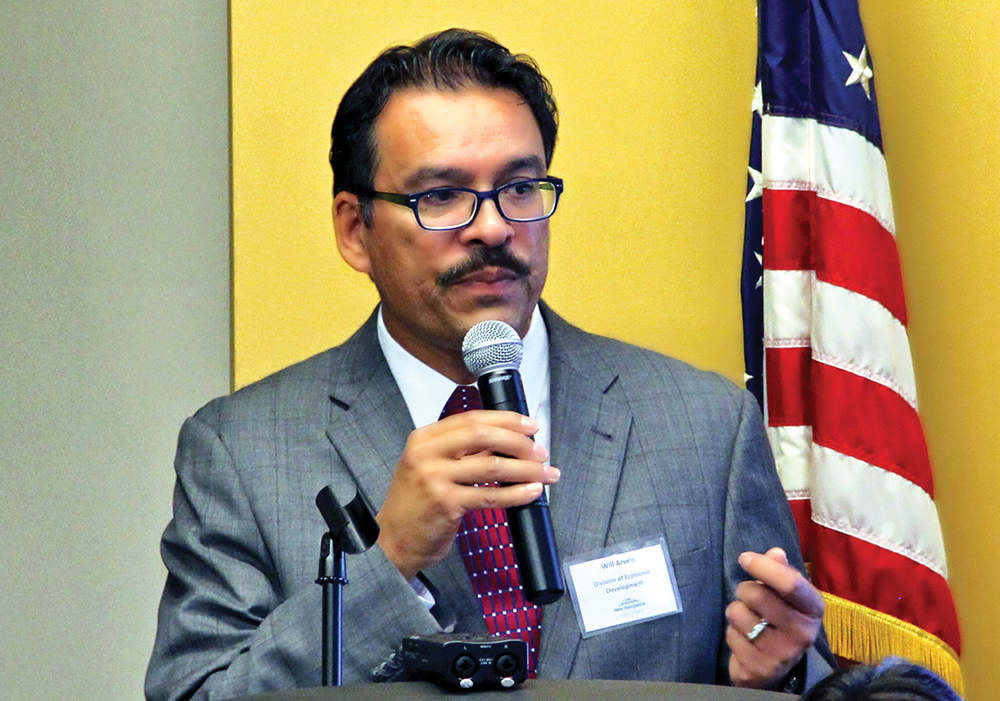
A growing number of NH government, business and community leaders say there’s an easy way to understand how critical diversity is to the state’s economic future: Do the math.
In a state where the 2.6 percent unemployment rate is even lower than the national average of 4.2 percent, working-age residents are sorely needed and there aren’t enough workers to meet the demand—nor are there likely to be in the foreseeable future.
New Hampshire is the third whitest state in the nation (94 percent of the population is white), after Maine and Vermont, both at 95 percent, according to 2017 U.S. Census Bureau statistics.
According to a 2016 report from the Carsey School of Public Policy at the University of NH, more whites died than were born in 17 states in 2014 compared to just four in 2004, including NH. The research found that non-Hispanic white deaths are exceeding births in NH because more whites are dying and fewer white babies are being born.
This is compounded by the majority of college-bound high school graduates in NH—59.6 percent—choosing to attend four-year colleges out of state, according to a 2016 state Department of Education report. And when they leave they often don’t come back.
Also, the overall number of young people in the state is falling. Exeter-based demographic expert Peter Francese notes that between 2010 and 2017, the state population of those under 18 declined almost 10 percent and the number of those in the prime working years of 25 to 44 declined by 2.5 percent. Meanwhile, those in the 65 and older group grew by 32.5 percent.
Only immigration allowed the population to grow at all in that time period, at a rate of 2 percent, with immigrants accounting for 50.4 percent of that growth, according to Francese.
Even with that, NH has not kept up with the rest of the nation in diversifying its ranks. While the U.S. as a whole is 18 percent Latino, 13 percent black or African-American and 6 percent Asian, according to the U.S. Census Bureau, NH is 4 percent Latino, 2 percent black and 3 percent Asian. Many of those populations are growing due to higher birth rates, adding to the sense of urgency to make NH welcoming for people of diverse backgrounds as it seeks to bolster its workforce.
Diversity’s Big Tent
It’s not just people of different races the state is seeking to attract. “We need to bring in anyone who is willing to work, whatever race or ethnicity,” says Tina Sharby, board president of the Diversity Workforce Coalition, a group of NH employers that promote diversity in the workplace.
In using the word diversity, “we would include seniors, transgenders, military veterans, people with socioeconomic differences, people who are differently-abled,” adds Sharby, who is also chief human resources officer at Easterseals NH.
“If somebody is productive, we can’t leave anybody behind. I think that’s a moral imperative,” says Will Arvelo, director of the NH Division of Economic Development.
Workforce Diversity Taskforce
So acute is the problem that Gov. Chris Sununu established a Governor’s Council on Diversity and Inclusion last December, and government, business and community leaders met this July to launch a statewide taskforce on workforce diversity.
Organizers of the July gathering included the NH Division of Economic Development, Endowment for Health, Easterseals and Eversource, which hosted the event at its Manchester office. The roughly 80 participants represented entities ranging from the NAACP to nonprofits to the NH Automobile Dealers Association, all committed to working together to advance diversity efforts in order to attract and retain more workers.

Panelists Loretta Brady, chair of the Greater Manchester Chamber of Commerce’s Joint Task Force on Immigrant Economic Integration; Tye Graham, senior VP and director of HR business partnerships for Eastern Bank; and Rogers Johnson, president of the Seacoast NAACP, at the July Governor’s Advisory Council on Diversity and Inclusion meeting. Courtesy of Eversource.
Attendees networked and met in small groups to brainstorm ideas. Among the suggestions: Establish reciprocal licensing agreements to allow immigrants to continue using their skills, involve legislators, develop a speakers bureau on diversity and inclusion, start a marketing campaign to attract out-of-state workers, and make housing and transportation more accessible for newcomers.
The task force, which does not yet have a name, will have future meetings “to continue that conversation,” says Arvelo, who moderated a panel at the event.
The group’s message, however, was not universally welcomed. Following the meeting at Eversource, an editorial in a state newspaper denounced the diversity push as unnecessary, the state Department of Education communications director made derogatory comments on his private Facebook page, and several participants received threatening phone calls or emails, some of which were referred to law enforcement officials.
Some participants later said they thought the objective of the meeting was misunderstood. “The purpose of the minority business discussion was to create a better economic situation, and that message was getting lost in the backwash and that’s unfortunate,” says Rogers Johnson, president of the Seacoast NAACP and chair of the Governor’s Advisory Council on Diversity and Inclusion. “By creating diversity, this is not an instance where, by achieving one thing, we’re taking away from someone else. What we’re doing is trying to improve the opportunities for everyone, and that should be the focus.”
Sharby says that the meeting “was not all about race and ethnicity. One person wanted to know how to get female individuals on his board, or someone with a disability. To see it get so spun was very disheartening, which is unfortunate.”
Distress over the backlash has led at least three people to join the Diversity Workforce Coalition, she adds.
NH Needs More Young People
Others say recruitment efforts should have a different emphasis. “The bottom line is, diversity in New Hampshire is irrelevant because what New Hampshire needs is more young people, period,” says Francese. But he notes that attracting or retaining more young people will itself produce a more varied workforce because “young people across America are more diverse than older people … Among people under the age of 20, approximately half are of one minority group or another, so young people by definition are diverse. Older people are not as diverse.”
Nationally, those younger people are creating a huge demographic shift, with the Census Bureau predicting that whites will actually constitute less than half the population by 2050. Meanwhile, some areas of NH are seeing more diversification of their populace and an economic boost because of it, according to business leaders.
In the state’s largest city, Manchester, the white population dropped from 92 percent in 2000 to 80 percent in 2017, by Census Bureau estimates, while the foreign-born population climbed 13.2 percent between 2012 and 2016.
Michael Skelton, CEO and president of the Greater Manchester Chamber of Commerce, says diversity has “without question” bolstered the local economy. “Manchester is home to many businesses that perhaps have the strongest talent pool and workforce pool, and one reason is the size of the diversity,” he says. “We can definitely attest to the economy of Manchester doing really well and can tie that right back in to the workforce and talent pool.”
Sharby notes that Easter Seals created an immigrant/refugee training program to employ immigrants, and “I know it has helped us as an organization.”
The Seacoast area, too, scores higher on the diversity scale than many parts of the state, with Portsmouth, Dover and Rochester being listed among the most ethnically mixed cities in the nation by the personal finance website WalletHub. “To the degree that we can draw younger people because it contains the diversity they seek, the Seacoast economic situation will be demonstrably better than the rest of the state because we can attract those young people and, more important, new businesses that actually benefit everyone,” says Johnson.
Policies Matter
Attracting new businesses and the workers to staff them remains the challenge, business and community leaders agree.
How best to do that is the subject of continuing debate. Many cite a lack of affordable housing as a deterrent to attracting workers, particularly as more communities opt for “55 and older” or other age-restricted housing in what Francese says is the mistaken belief that it will keep local education costs and property taxes down.
Ten years ago, Francese and former state agricultural commissioner Lorraine Merrill coauthored a book, Communities and Consequences: The Unbalancing of New Hampshire’s Human Ecology & What We Can Do About It, warning of the short-sightedness of such an approach. (They are working on an update of that book to be released in 2019.)
The failure to heed their words “has really come back to haunt us,” says Arvelo. “Communities have to realize that building developments that are 55-plus, and that’s all, that’s not going to work long-term. They have to change if they’re going to welcome and retain younger workers and their families.”

Will Arvelo, director, NH Division of Economic Development. Courtesy photo.
“We need to market New Hampshire so we can be attractive to younger families, making sure we’re including veterans, people with disabilities, those in addiction recovery,” he adds. Businesses, too, can develop policies that are friendlier to older workers, allowing them to stay on the job longer and provide “knowledge transfer” to their younger cohorts, Arvelo says.
Sharby adds that better transportation access and neighborhoods that welcome diverse populations and cater to their customs may also help attract newcomers. “If you think back to when the mills were operational, it was a very vibrant economy,” she says, adding that the mills attracted many immigrants seeking work. “The difference between then and now is that then we provided communities, housing, transportation, the social aspect. Now, when immigrants settle in, we don’t do that.” She also sees a need for businesses to become more flexible so, for example, an older worker or one with disabilities who is unable to work a 40-hour week is still welcome in the workplace.
Johnson sees an opportunity for more individual outreach; for example, contacting historically black colleges and universities about criminal justice internships at NH police departments or student teaching assignments at NH schools.
Skelton at the Chamber sees potential and talent in the immigrant and refugee community “because that portion of our population is actually growing. The challenge is, how can we be more diverse and welcoming to those arriving in our community so they can potentially become part of the workforce, while at the same time build stronger and more inclusive communities?” he says.
Johnson says that those behind the diversity push are not seeking “to change the face of the state in a way that would be alarming to people. We’re not asking for the state to have a 13 percent black population mimicking the rest of the country, but we can have 5 percent. A company doesn’t necessarily have to hire a person of color, but if they have that person of color in front of them and they’re qualified, why wouldn’t they?”
He predicts any substantive change in the diversity of the population is going to take 10 or 15 years, “but you have to start someplace,” Johnson says, adding, “Nothing worthwhile ever came easy.”

 Current Issue - April 2024
Current Issue - April 2024